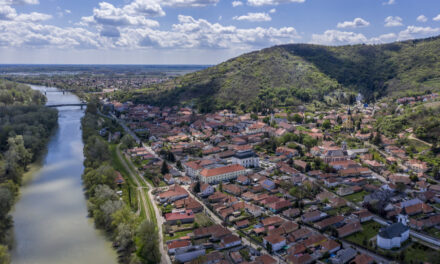The 1970s were considered a black decade in the history of Malév, the Hungarian national airline. Between 1971 and 1977, in the span of just six years, Malév lost a total of five aircraft in air accidents, and all disasters involved fatalities. The real causes of the last misfortune of the decade, the tragedy of Malév flight 203 between Istanbul-Bucharest-Budapest on September 21, 1977, which claimed 32 lives, were concealed by the Kádárist authorities for many years.
Police officers in Malév uniforms
On September 23, 1977, the main news on the front page of Népszabadság, the main paper of the Hungarian Socialist Workers' Party (MSZMP), was the brief announcement of the Ministry of Transport and Posts (KPM) during the coverage of the official meeting between Hungarian party leaders János Kádár and Yugoslav Joszip Broz Tito about the fatal accident involving Malév flight 203 two days earlier.
"On Wednesday, September 21, at 6:00 p.m. Hungarian time, the Malév 203, TU-134, flying according to schedule between Istanbul-Bucharest-Budapest, crashed during an emergency landing 55 kilometers from Bucharest. Fifty-three people were on board the plane - thirty-five Hungarian, four East German, six Turkish passengers and eight crew members - twenty-one passengers and eight crew members lost their lives; twenty-four - twenty-three Hungarians and one Turkish citizen - survived," wrote the KPM's official communique.
As is typical for the era of socialism, the first official announcement about the serious disaster was only published after the Hungarian-language broadcast of Radio Free Europe had already reported on the tragedy.
The KPM's notice wrote about an emergency landing, as if implying
that the plane could have suffered a technical failure, when in fact serious human error was the main cause of the disaster
– true, this only became known in all its details many, many years after the accident. Tupoljev's Tu-134 twin-engine jet passenger plane with registration number HA-LBC - nicknamed only Cecíl by the pilots - took off from the Istanbul International Airport on September 21, 1977.
There were eight crew members and forty-five passengers on board the plane. Most of the Hungarian passengers, including a group of young people from the Express Travel Agency, were returning home from a sightseeing program in Istanbul.
The plane was controlled by Miklós Bakcsi "chief pilot" and Péter Fejes "pilot" on the flight,
but apart from them, there were also radio-navigator László Révbíró, ship radio operator András Bohner, and ship mechanic László Bocskai, all of whom served in Malév uniforms.
The designations "chief pilot" and "pilot" in the later official report on the accident may have seemed strange from the outset, since Malév's service positions were not given these names,
instead, the titles of aircraft commander (today: captain) and co-pilot (today: first officer) were used. However, these names could not be traced back to some kind of mess, but to the fact that the cabin crew of flight 203 did not belong to Malév, but to the Ministry of the Interior.
The chief pilot had serious objections, and no trace of his notes was lost
The official communiques issued about the accident intentionally kept silent about the fact that at the time of the disaster, the crew of flight 203 was not operated by Malév pilots, but by the Ministry of the Interior (BM) III. It was given by aircraft pilots belonging to the staff of the V. (Aviation) Sub-Division of the Government Guard of the State Security Main Group Chief.
Until 1972, the government flights of the highest party and state leaders were carried out by carefully selected personnel from Malév and the Hungarian People's Army Air Force.
However, from 1972, the two available Tu-134 pilot planes were operated exclusively by the BM Government Guard,
with its own staff from the Ministry of the Interior. (By the way, the two steering machines had a total of three complete flight crews, ed.)
The two pilot planes, on the other hand, hardly ever flew, so the skills of the service personnel were also "rusty" due to the extremely low number of flight hours. From this point of view, it was particularly unfortunate that the first secretary of the MSZMP, János Kádár, had a strong fear of flying, so whenever he could, he used the special government train for his visits abroad instead of the government planes.
Therefore, at the initiative of the Ministry of the Interior, the agreement reached between the BM and the KPM in 1976 made it possible for pilots belonging to the BM sub-division to fly the planes of the national airline in Malév uniforms in order to maintain their level of training.
Of course, none of the "competent comrades" asked Malév's opinion on this in advance.
At that time, András Fülöp was the chief pilot of Malév's Tu-134 jet passenger carriers.
He trained the BM pilots, including police lieutenant colonel Miklós Bakics and police major Péter Fejes, for the type. Miklós Bakics previously served as a military pilot in the Hungarian People's Army, from where he was transferred to the BM staff. However, András Fülöp praised the BM pilots for their performance during the retraining
he did not consider him suitable for the Malév service, about which he also prepared an official report.
The officials of the BM avoided the Malév chief pilot's "untraining" by sending Miklós Bakics and Péter Fejes to Moscow for retraining, where they had already received the type license.
Although the internal affairs pilots flew the airline's scheduled planes in the colors of Malév, neither the professional management of Malév nor the chief pilot of the type had any control rights over them, which was not only unprecedented, but a situation that directly contradicted international aviation conventions. There is another interesting thread to this story: after the tragedy of flight 203, the report discussing the incompetence of the pilots was removed from the documents, so the "unpleasant" note of András Fülöp was completely lost.
"Now what happened?"
The Istanbul start continued with an uneventful flight until the start of the descent towards Bucharest-Otopen International Airport.
However, the crew took it very lightly to carry out the mandatory pre-landing checklist accurately,
which caused an error that played a serious role in the occurrence of the disaster: during the reading of the checklist, the barometric altimeters were not set to the air pressure of the Bucharest-Otopeni airport due to carelessness. It was due to this wrong instrument setting that when they started the descent towards Bucharest, the instruments showed false altitude values.
Air traffic control in Bucharest gave a threshold altitude of 1,860 feet (600 meters) to begin the landing. When they reached this height according to the instrument, Miklós Bakcsi gave instructions to release the landing gear. But because of the aforementioned miscalibration
at that time they were already flying lower than the safety minimum.
This error alone would have been enough to cause the extraordinary flight incident, but the dangerous situation was made even worse by the fact that the interceptors (brake plates) built into the wings opened together with the landing gear.
(The interceptors normally open only when the machine has already touched concrete, and their role - together with the jet reverser - is to increase the air resistance to stop the machine.) Due to the released landing gear and the opened brake pads, the speed was significantly reduced, and the plane began to descend at a rapid rate.
However, neither the pilots nor the air traffic control noticed this.
The cabin crew only realized that something might be wrong when the ground proximity indicator on the radio altimeter turned on at sixty meters. The audio from the flight data recorder (the so-called black box) captured the shock of the unexpected signal, as someone shouted out, "What just happened?"
At the same time, they also realized that the brake pads were open. "Pull the ceptor back!" - the nervous instruction can be heard on the recording. In the last moments of the sound recording recorded by the "black box", the rumbling of the engines can still be heard, which suggests that the pilots tried to gain altitude by increasing the engine power. However, it was already too late, and the HA-LBC Tu-134 crashed into a field at high speed, 55 kilometers from the Bucharest airport, on the border of Urziceni.
A huge crash was heard, then smoke and flames engulfed the wreckage
Not a single member of the flight crew survived the disaster, and twenty-one of the passengers lost their lives. Twenty-four survived the accident, twenty-three Hungarians and one Turkish citizen. The on-site inspection held after the accident revealed that the plane, descending intensively at high speed, first skidded through a pine grove and then crashed into a field behind the trees.
The momentum still carried the plane over the first irrigation canal, but not over the second one: the nose runner broke off, and the first section of the plane was torn off together with the cockpit, which the fuselage neatly crumpled under itself. Everyone who was in the section before the fault line of the trunk died a horrible death. The middle part of the fuselage swung even further due to the inertial force, while the tail part also broke off. The wreckage of the Tu-134, broken into three pieces, burned with a blazing flame in the dark night.
The survivors, trapped in the middle and rear section of the split fuselage, broke through the thick smoke and flames and jumped out of the increasingly intensively burning wreck in a state of shock. One of the survivors, László Babucs, recalled the dramatic moments of the tragedy like this: "We were in front of Bucharest when the flight attendant announced that everyone should sit down and fasten their seat belts... Not even fifteen or twenty seconds had passed, it was unbelievable the plane began to oscillate, sometimes up, sometimes down. We were sitting level with the plane's wing and looking out the window, and when the plane started to wobble as if we were in a vortex, I looked to the left and it was as if I saw a tongue of flame at the end of the wing.
- And then my stomach went up into my throat to a terrible extent, we went down and there was a huge explosion, a crack, a flash, a roar - as if some lightning had struck the plane - and then terrible screams and snoring. I couldn't imagine what happened because I've flown several times before, and then it was as if we stopped. I opened my eyes, and one and a half to two meters away, the plane was broken, in front of me was a huge tongue of flame, like the one through which the lions jump in the circus.
Dr. traveled on flight 203. Zoltán Magyari and his wife, dr. Pastor Annamária as well. According to Dr. Zoltán Magyari's recollection, they had already strapped themselves into their seats at the request of the flight attendant, and a late passenger was just making his way back to his seat next to the row of seats in front of them, when a terrible crash was heard. The fuselage of the plane was hit by a huge blow, and the rows of seats in front of them and the man rushing to their place simply disappeared in the torn opening.
According to Dr. Magyari, a huge noise and screaming broke out, the lights went out, and the wreckage began to be engulfed in flames. He and his wife were extremely lucky; since the nose part of the plane broke off right in front of them, they just unbuckled their seat belts and simply jumped down to the ground.
The residents of nearby Urziceni first appeared at the scene of the accident, bringing blankets and drinks, and the wounded were brought into the village, where the local doctor, who had been alerted in the meantime, and Dr. Magyari, who had suffered a rib fracture, began to treat the injured.
The test is closed, forget it!
The Hungarian authorities received the very first information about the Malév plane disaster from the Romanian air traffic control. The survivors, who were in a state of shock, were taken to Hungary by bus from Bucharest the next day.
By a twist of fate, the Romanian bus also caught fire on the way.
The ordeal home journey from Romania ended in Szeged, where Malév officials were waiting for the survivors of the disaster, who were taken from there by taxi.
In the days that followed, the survivors were approached by BM employees in gray suits and told
it is "not recommended" to talk to the press or anyone else about the disaster.
Until the regime change, it was not revealed who was driving the ill-fated Malév plane. The disaster, which claimed many lives, was caused by human error and a technical failure beyond the control of the pilots, the opening of the interceptors.
Featured image: András Fülöp was a former type chief pilot and training instructor for BM pilots. Source: Tu-154.hu












